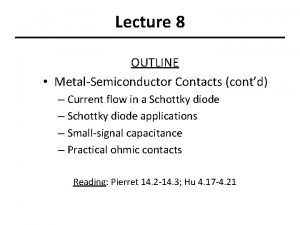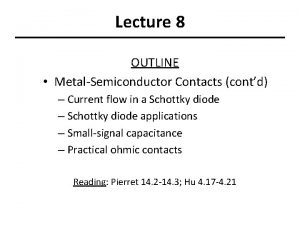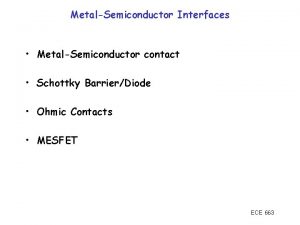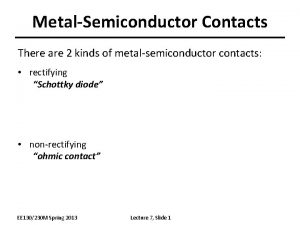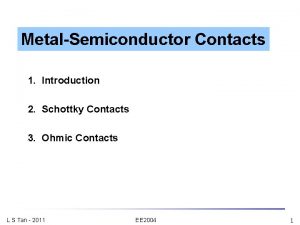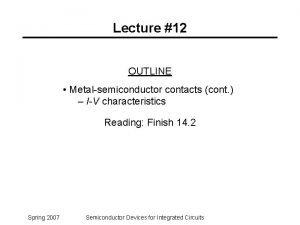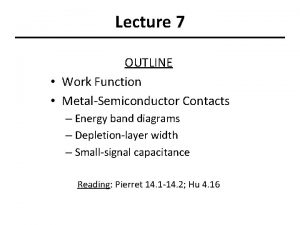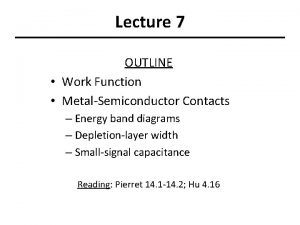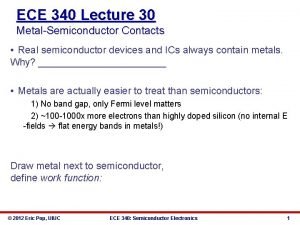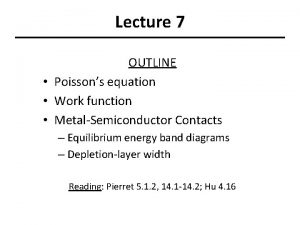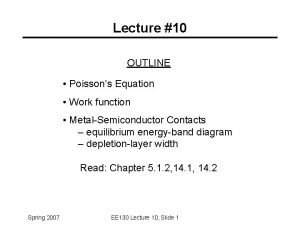Lecture 8 OUTLINE MetalSemiconductor Contacts contd Current flow













- Slides: 13

Lecture 8 OUTLINE • Metal-Semiconductor Contacts (cont’d) – Current flow in a Schottky diode – Schottky diode applications – Practical ohmic contacts Reading: Pierret 14. 2 -14. 3; Hu 4. 17 -4. 21

Current Flow FORWARD BIAS REVERSE BIAS • Current is determined by majority-carrier flow across the M-S junction: o Under forward bias, majoritycarrier diffusion from the semiconductor into the metal dominates o Under reverse bias, majoritycarrier diffusion from the metal into the semiconductor dominates R. F. Pierret, Semiconductor Fundamentals, Fig. 14. 3 EE 130/230 A Fall 2013 Lecture 8, Slide 2

Thermionic Emission Theory • Electrons can cross the junction into the metal if R. F. Pierret, Semiconductor Fundamentals, Fig. 14. 3 • Thus the current for electrons at a given velocity is: • So, the total current over the barrier is: EE 130/230 A Fall 2013 Lecture 8, Slide 3

Schottky Diode I - V For a nondegenerate semiconductor, it can be shown that We can then obtain In the reverse direction, the electrons always see the same barrier FB, so Therefore EE 130/230 A Fall 2013 Lecture 8, Slide 4

Applications of Schottky Diodes • IS of a Schottky diode is 103 to 108 times larger than that of a pn junction diode, depending on FB. Schottky diodes are preferred rectifiers for low-voltage, high-current applications. Block Diagram of a Switching Power Supply EE 130/230 A Fall 2013 Lecture 8, Slide 5

Practical Ohmic Contact • In practice, most M-S contacts are rectifying • To achieve a contact which conducts easily in both directions, we dope the semiconductor very heavily W is so narrow that carriers can “tunnel” directly through the barrier EE 130/230 A Fall 2013 Lecture 8, Slide 6

Tunneling Current Density Equilibrium Band Diagram EFM q. Vbi FBn Ec, EFS Ev EE 130/230 A Fall 2013 Lecture 8, Slide 7 Band Diagram for VA 0 EFM q(Vbi-VA) Ec, EFS Ev

Example: Ohmic Contacts in CMOS EE 130/230 A Fall 2013 Lecture 8, Slide 8

Specific Contact Resistivity, rc • Unit: W-cm 2 – rc is the resistance of a 1 cm 2 contact • For a practical ohmic contact, want small FB, large ND for small contact resistance EE 130/230 A Fall 2013 Lecture 8, Slide 9

Approaches to Lowering FB • Image-force barrier lowering FBo EF metal DF N = dopant concentration in surface region a = width of heavily doped surface region Ec n+ Si Very high active dopant concentration desired • FM engineering – Impurity segregation via silicidation A. Kinoshita et al. (Toshiba), 2004 Symp. VLSI Technology Digest, p. 168 – Dual ( low-FM / high-FM ) silicide technology • Band-gap reduction – strain A. Yagishita et al. (UC-Berkeley), 2003 SSDM Extended Abstracts, p. 708 C. Ozturk et al. (NCSU), – germanium incorporation M. 2002 IEDM Technical Digest, p. 375 EE 130/230 A Fall 2013 Lecture 8, Slide 10

Voltage Drop across an Ohmic Contact • Ideally, Rcontact is very small, so little voltage is dropped across the ohmic contact, i. e. VA 0 Volts equilibrium conditions prevail EE 130/230 A Fall 2013 Lecture 8, Slide 11

Summary • Charge is “stored” in a Schottky diode. – The applied bias VA modulates this charge and thus the voltage drop across the semiconductor depletion region The flow of majority carriers into the metal depends exponentially on VA EE 130/230 A Fall 2013 Lecture 8, Slide 12

Summary (cont’d) • In equilibrium the flow of carriers from M to S (IM S) equals the flow of carriers from S to M (IS M) • Under forward bias IS M increases exponentially and dominates • Under reverse bias IS M decreases exponentially so that IM S (which is independent of VA) dominates Since it is difficult to achieve small FB in practice, ohmic contacts are achieved with heavy doping, in practice. EF Ec Ec EF Ev EE 130/230 A Fall 2013 Lecture 8, Slide 13 Ev
 Alliance future internetlapowskyprotocol
Alliance future internetlapowskyprotocol 01:640:244 lecture notes - lecture 15: plat, idah, farad
01:640:244 lecture notes - lecture 15: plat, idah, farad Lecture outline example
Lecture outline example Lecture outline example
Lecture outline example Lecture outline example
Lecture outline example Lecture outline meaning
Lecture outline meaning Line current and phase current
Line current and phase current Difference between phase voltage and line voltage
Difference between phase voltage and line voltage Energy band diagram of pn junction diode
Energy band diagram of pn junction diode Ac systems lesson 4
Ac systems lesson 4 Drift current and diffusion current in semiconductor
Drift current and diffusion current in semiconductor Intrinsic semiconductor
Intrinsic semiconductor The constant-current region of a fet lies between
The constant-current region of a fet lies between Line current and phase current
Line current and phase current














